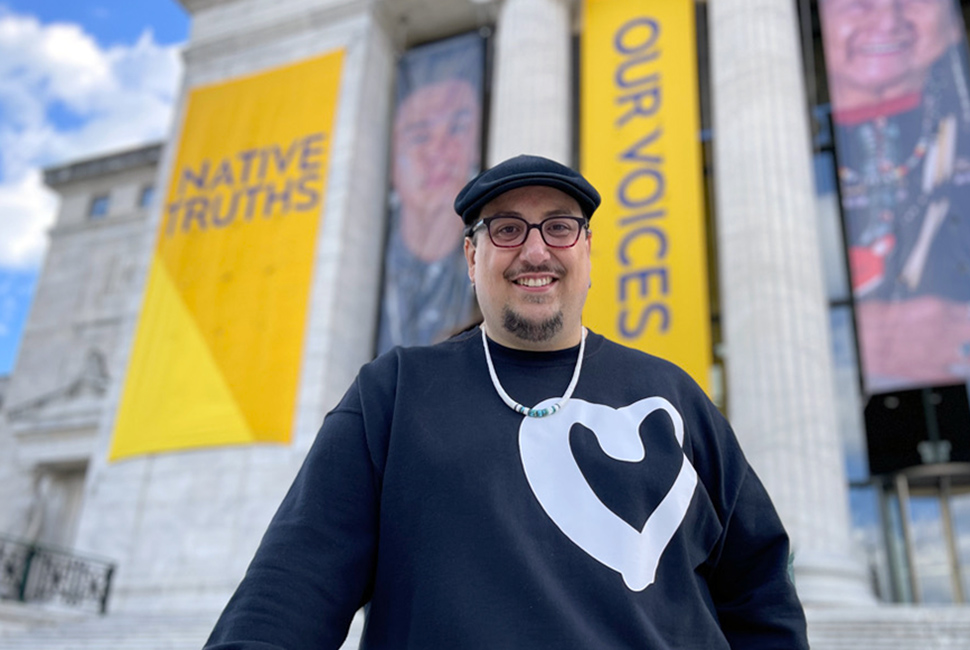On one wall, visitors can learn about the histories of removal from places like Wisconsin, and the treaty histories behind it. “It is important the way the exhibition emphasizes that non-Native people, our treaty partners, are also bound to those treaty agreements that are made with Native people. They're not just one-way documents,” Kiel said.
But how did an institution founded on “salvage anthropology,” a grabbing up of treasures presuming a people will inevitably become extinct, create such a vivid, multifaceted and authentic representation of Native Americans when Indigenous people have been largely misrepresented from its inception?
The Field Museum — from the top down — was fully committed to collaborating with Indigenous communities and was invested in creating a process that would place Indigenous people at the center of the exhibition’s planning and caretaking, Kiel said.
The advisory council’s main roles were to help museum staff conceptualize what a great exhibition would look like and help them to think about developing better relationships with Indigenous communities at the museum.
Realizing time and space limitations would not be able to accommodate the full breadth and diversity of viewpoints and experiences, “Native Truths” was conceived of as an ongoing, living collection with gallery spaces ceded back to the Native communities represented.
To highlight the natural history of treasures from the Field Museum’s collection, while representing as many Indigenous communities from North America as possible, the advisory committee established a set of big ideas to guide the exhibition narrative and unite the many geographically and culturally distinct Indigenous groups the Field Museum sought to include in the process.
“All of us can identify with overarching themes like, ‘We speak for ourselves,’ ‘Native people are everywhere’ and ‘Our Ancestors connect us to the past, present, and future.’ Planting seeds is what this exhibition is about,” Kiel said.
The exhibition offers something more substantial than a land acknowledgement, which Doug Kiel says can be a superficial stand in for a more nuanced understanding of history.
A different experience for Native communities
“I had heard many times over the years from Native American visitors how painful it was to visit the old hall,” said Alaka Wali, curator emeritus of North American anthropology at the Field Museum.
"Throughout its history, the Field Museum collected items from Native communities in ways that were sometimes unscrupulous," Loew said. "It was important to us as advisors — and our museum collaborators agreed — that the Field own up to those practices. That acknowledgment is also a Native Truth evident in the exhibit. It goes a long way to help heal the relationship between the Field and Native communities."
“When we began work on the new hall, we knew we wanted it to be a completely different experience for Native community members. We wanted it to be welcoming, and a place they could feel they could claim as their own. Our advisory committee played a major role in consistently reminding us to approach the redesign with Native American audiences in mind,” Wali said.
The strength of Field’s partnerships with Native communities can be felt from the moment visitors enter the exhibition.
Wooden planks milled from the trunk of a 191-year-old eastern white pine provides the gallery’s benches and maple trees its flooring. The trees were gifted by the Menominee Nation in northeastern Wisconsin, including a giant pine that took root in the Menominee Forest in 1831, just prior to Chicago’s incorporation in 1833. A cross-section of the same white pine is central to an exhibit on Indigenous activism in the U.S., its rings used to mark off a timeline of historical events. White birch bark panels the walls, enveloping visitors in the hush and warm tone of an old-growth forest. The sights and sounds of fields, forests, skies and lakes are projected floor to ceiling to enhance the sensory experience.
Rotating galleries on Lakota music, Meskwaki seeds, New Mexico’s Chaco Canyon and the California basket weavers will turn over with new artworks, practices and stories being told. The Field Museum has established an endowment to continue the process of renewing the exhibits and returning those objects back to their communities.
To include as many Native voices as possible, collaborators were given video cameras as a pandemic workaround to document ancestral stories and community practices, giving the exhibition a unique intimacy.
In one rotating gallery, a member of the Meskwaki Tribal Settlement in Iowa narrates a video documenting food sovereignty practice. A multigenerational family is shown planting, harvesting, and boiling its ancestral corn and collecting the colorful seeds for future sowing. The story provides a living, scientific context for the glass containers of seeds from the Field’s botanical collection also on display.
Providing a formative experience for children
The most essential audience for “Native Truths” is the Native community in Chicago and beyond. Given the Field Museum’s historically poor reputation with these groups, Kiel often wondered how Indigenous audiences would receive the exhibition.
Among the opening events planned by museum leaders for Native American audiences was a preview for the collaborators and their families. Kiel said the staff expected to receive 250 RSVPs. The enthusiasm for the exhibition surpassed all expectations when the invitation was accepted by 400 community members and nearly 600 turned out for the opening.
Realizing a large percentage of Field Museum visitors are families with young children and groups of Chicago Public School students, Kiel hopes the exhibition will empower teachers to improve classroom teaching and curriculum and serve as a formative experience for children. With annual visits of 1.2 million annually to the Field Museum, the staff estimates that more than half a million could see “Native Truths” in its first year.
“Having our own elders filmed telling stories to be shared with future generations in the museum setting is a really incredible resource for schools,” Kiel said. “Patty (Loew) and I both come from communities with seventh-generation planning. We are mindful that our actions today affect our descendants seven generations into the future.
“With ‘Native Truths’ all of us are trying to build something that will have a lasting impact and in a positive way. I’d like to see this as the beginning of a new period which is nothing but a positive legacy for the Field Museum.”
The Field’s commitment to partnering with Native communities on the hall’s renovation and reopening is a harbinger of an emerging movement of Native Americans reclaiming space and taking ownership of their stories.
“Museums are a place to correct misinformation and envision positive change,” Kiel said. “One of the things that excites me most is the way museums can connect with young people. The first visit to a museum with a school trip or family stays with you. It is an experience you remember the rest of your life.”



